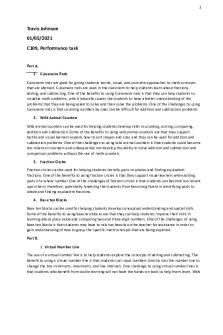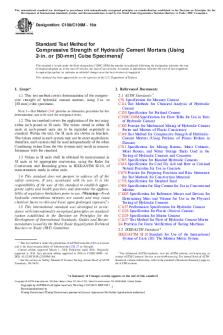Math Methods C109 Performance Assessment PDF

| Title | Math Methods C109 Performance Assessment |
|---|---|
| Course | Educational Technology for Teaching and Learning |
| Institution | Western Governors University |
| Pages | 7 |
| File Size | 104.7 KB |
| File Type | |
| Total Downloads | 68 |
| Total Views | 172 |
Summary
Download Math Methods C109 Performance Assessment PDF
Description
Elementary Mathematics Methods - C109 Performance Assessment
Nichole Sargent #000670787
Part A: Hands-on Manipulatives
http://www.hand2mind.com/category/math/manipulatives/3168
Manipulative 1: Cuisenaire Rods can be a great tool to help assist in understanding fractions, as well as many other concepts. They provide an easy to use, physical representation that students can practice with. One disadvantage is that smaller rods would be easily lost, especially with younger and/or less organized students.
Manipulative 2: Folding Geometric Shapes can be used to help with comparing attributes of different geometrical figures. They can allow students with limited understanding to see the three dimensional aspect of a shape. They could be distracting for students who are prone to get off task during independent practice.
Manipulative 3: Fraction circles are a great manipulative to help students learning basics of fractions. They allow students to visualize fractions, which could be especially helpful if they are having trouble adding and subtracting fractions. They are, however, one of the less cost effective manipulatives.
Manipulative 4: Transparent counters are a great tool for teaching basic math skills, especially in younger classrooms. They are very cost effective, compared to some of the other manipulatives. However, counters are not quite as versatile or multi-purpose as some of the other manipulatives.
Part B: Virtual Manipulatives http://www.glencoe.com/sites/common_assets/mathematics/ebook_assets/vmf/V MF-Interface.html Virtual Manipulative 1: The place-values work mat is an excellent virtual manipulative to help students master the concept of place values when working with decimals with several digits. One advantage is that it is presented in a simple, easy-to-use table format. A disadvantage is that such a simple table format could be somewhat limited in uses.
Virtual Manipulative 2: The first quadrant grid work mat could be very useful when
teaching graphing. This could be a huge help students who struggle with the use of grid paper, and is easily legible. A disadvantage is that it would only be helpful in the first quadrant sections.
Virtual Manipulative 3: Virtual fraction tiles help students visualize fractions, and reinforce relational skills. One advantage is that they can be used for many different lessons in a variety of ways. A disadvantage could be that they require some additional observation to ensure they are being used correctly.
Virtual Manipulative 4: A virtual geoboard with geobands can be used to help students become familiar with geometric shapes. An advantage of these virtual geoboards is that they are less likely than the physical counterpart to become a distraction. One potential disadvantage is that they could be less helpful for students who benefit best from tactile elements of a lesson plan.
LESSON PLAN GENERAL INFORMATION
Lesson Title & Subject(s): Fractions: Adding Fractions with Different Denominators Topic or Unit of Study: Math Grade/Level: 5th Instructional Setting: Classroom setting of 25 students. The class has 2 ELL students, one who is nearly fluent, and one with emerging English skills, 2 students with IEPs for behavioral issues including ADHD, and 1 gifted student. Students are seated in groups of 5.
STANDARDS AND OBJECTIVES Your State Core Curriculum/Student Achievement Standard(s): Use equivalent fractions as a strategy to add and subtract fractions. Lesson Objective(s): Given Cuisenaire Rods and a set of sample problems of addition of equivalent fractions with different denominators, students will be able to determine the answers with 80% accuracy.
MATERIALS AND RESOURCES Instructional Materials: Overhead projector Smartboard 5 sets of cuisenaire rods 5 calculators Each student has a personal math journal and a pencil Manipulative: Cuisenaire Rods Resources: None
INSTRUCTIONAL PLAN Sequence of Instructional Procedures/Activities/Events (provide description and indicate approximate time for each):
1. Student Prerequisite Skills/Connections to Previous Learning: Students will need to have a functional understanding of fractions and basic addition skills. They will also need to be able to work cooperatively in a small group setting. 2. Presentation Procedures for New Information or Modeling: (5 minutes) During this portion of the lesson plan, I would use the overhead projector to demonstrate how cuisenaire rods can be used to represent fractions. I would take a few moments during this time to activate prior knowledge, by starting with an example of adding like fractions. Example: 1/3 + 2/3 I would ask the class as whole to volunteer answers to simple fraction addition problems like the example above, that I write on the projector, and demonstrate how to use the cuisenaire rods to help find the answer. From there, I would move on to a sample problem involving fractions with different denominators, demonstrating how to use the cuisenaire rods to represent equivalent fractions. Example: ⅙ + ⅔ At this point, I would allow a few moments for students to ask any questions they may have. 3. Guided Practice: (15 min) Students would then works in groups at their tables, which were previously assigned using heterogeneous grouping overall, but with the 2 ELL students seated at in one group. Each table would have a set of cuisenaire rods, which they would be instructed to use to practice a set of problems written on the Smartboard. I would spend this time circulating around the room, to monitor the practice time, and ensure that all students are participating in the activity. Additionally, I would have written 2 additional questions of more advanced difficulty on another part of the board. Once each group had finished the problems, they would write their answers on the smartboard.
4. Independent Student Practice: (10 minutes) During this section of the lesson, students would independently complete a worksheet of similar problems, which they would hand in at the end of the allotted time. I would use the results from these worksheets to determine whether or not the students had met the objective.
5. Culminating or Closing Procedure/Activity/Event: 5 minutes Students would complete an entry in their personal journals, describing what they learned in the lesson, and one way that they think they might be able to use it in the future. Instructional Strategy (or Strategies): Cooperative learning Heterogeneous grouping Metacognitive learning
Differentiated Instruction Accommodations: Subgroup: ELL students This lesson plan appropriately accommodates the ELL students in the class through the use of manipulatives, and by placing the 2 Spanish-speaking students together in a group with other students. Subgroup: Gifted Student I have accommodated the needs of the gifted learner in this classroom by providing additional practice questions that are slightly more difficult, and by grouping the gifted learner with other students of varying abilities.
Use of Technology: Smartboard Student Assessment/Rubrics: I would review students’ mastery of the objective by giving an informal assessment during the lesson, in a worksheet format. Answering 4 of the 5 questions would sufficiently demonstrate mastery.
Part D Students used Cuisenaire Rods to add fractions in cooperative groups during the guided practice portion of the lesson. Allowing the students to work with the cuisenaire
rods was strategic, because it provided a tangible representation of the concept being taught in the lesson. It also had the added benefit of encouraging participation in small group settings, which increases student engagement. Part E Critical Thinking - This lesson required students to do reflective journaling during the closing portion of the class. This activity allowed students a good opportunity to use critical thinking skills in their entries, in which they were asked to describe what the had learned in class, and to speculate as to another way they may be able to apply the knowledge. Problem Solving - During the independent practice part of this lesson, students completed an informal assessment. This required them to utilize problem- solving skills in solving of the equations provided without assistance. Performance Skills - Students were placed cooperative groups during the guided practice portion of the lesson, and were given cuisenaire rods as a hands-on manipulative to work with. This part of the lesson plan encouraged them to use performance skills by requiring each group to work together as a team to solve a set of problems provided. Part F In this lesson plan, I chose to use the instructional strategy of cooperative learning groups. During the guided practice sections of the class, the students were placed in heterogeneous table groups, and given a set of problems to work on as a team. This evidence-based strategy is very useful. In this lesson plan, it was beneficial because it allowed students to interact with their peers, which facilitates comprehension. It also easily allowed for differentiating instruction for the students in the class with exceptional needs....
Similar Free PDFs

C109 Math Methods Task 1
- 6 Pages

C109 performance task
- 10 Pages

Math Methods Task
- 8 Pages

ASTM C109 - ASTM C109
- 10 Pages

Performance Assessment Task 2
- 4 Pages

Performance Assessment C700
- 8 Pages

Math SL Internal assessment
- 16 Pages

2017 Math Methods exam 2
- 25 Pages

C109 Task 1 - C109 Task 1
- 5 Pages

Geo assessment ch-1-performance
- 5 Pages
Popular Institutions
- Tinajero National High School - Annex
- Politeknik Caltex Riau
- Yokohama City University
- SGT University
- University of Al-Qadisiyah
- Divine Word College of Vigan
- Techniek College Rotterdam
- Universidade de Santiago
- Universiti Teknologi MARA Cawangan Johor Kampus Pasir Gudang
- Poltekkes Kemenkes Yogyakarta
- Baguio City National High School
- Colegio san marcos
- preparatoria uno
- Centro de Bachillerato Tecnológico Industrial y de Servicios No. 107
- Dalian Maritime University
- Quang Trung Secondary School
- Colegio Tecnológico en Informática
- Corporación Regional de Educación Superior
- Grupo CEDVA
- Dar Al Uloom University
- Centro de Estudios Preuniversitarios de la Universidad Nacional de Ingeniería
- 上智大学
- Aakash International School, Nuna Majara
- San Felipe Neri Catholic School
- Kang Chiao International School - New Taipei City
- Misamis Occidental National High School
- Institución Educativa Escuela Normal Juan Ladrilleros
- Kolehiyo ng Pantukan
- Batanes State College
- Instituto Continental
- Sekolah Menengah Kejuruan Kesehatan Kaltara (Tarakan)
- Colegio de La Inmaculada Concepcion - Cebu





